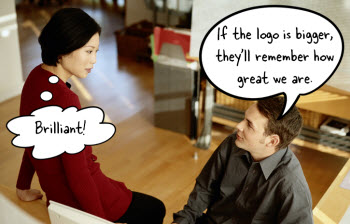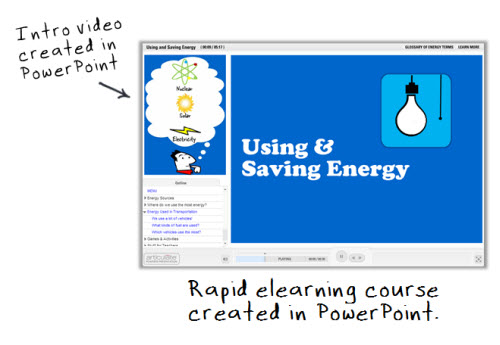[…] post originale di Tom Kuhlmann sul “Rapid E-Learning Blog”. Il post originale è disponibile qui jQuery(document).ready(function($) { […]
Does Your Client Need to Know You’re Using PowerPoint?
October 2nd, 2012
Many organizations have rules on using PowerPoint. But there’s a difference between elearning courses and slide presentations. How you use PowerPoint and its features is different; and so is the output. The only thing that’s the same is the application.
However, it never fails that once someone knows you’re using PowerPoint to build the rapid elearning course, they apply the same rules to your elearning course that they’d apply to presentations. And that causes issues.
PowerPoint is a Diverse Tool
Despite all of the complaints about PowerPoint it’s a very diverse product that is used to create everything from vector illustrations to elearning courses. The goal shouldn’t be to force a single guideline to all uses of PowerPoint. Instead it should be to clarify the final product and its objectives and THEN apply the appropriate guidelines.
Essentially PowerPoint is neutral. When it comes to presentations, it’s a blank slide waiting for content. But for creating an illustration, it’s a stage to assemble objects. And for elearning it’s a multimedia screen used learning.
But here’s the problem. Once your client knows you’re using PowerPoint to create the rapid elearning courses all bets are off. Instead of developing guidelines based on the output and objectives, they create restrictions based on the application being used, in this case PowerPoint.
That means they force the same requirements on your elearning courses that they force on presentations. And that’s not a good thing.
PowerPoint Branding Requirements
Many organizations have branding requirements when it comes to the use of PowerPoint. This makes more sense for public facing presentations. But the requirements for a presentation are not the same for elearning.
While there are many similarities between a presentation and elearning course, there are also many differences. In a presentation, the slide is all you see. Thus if you need to reinforce visual branding requirements, all you have is the slide area to do so.

But in an elearning course, the slide is for content and all of the real estate is valuable. In addition to the screen, the elearning course also has a player. If there are visual branding requirements, that’s the best place to put the logos and custom color schemes. It fulfills the requirement of the branding interests and it frees up valuable real estate.

When I managed a team of Flash developers I rarely ran into the same branding requirements that I did when using PowerPoint. Why is that? They’re both blank screens. The final output is Flash. But PowerPoint comes with a built-in bias. And most clients don’t know much about Flash. So they trust your expertise.
I tell my clients that if they have any PowerPoint content to give it to me as is. As far as they know, they’re just handing off content. I don’t need to tell them all the details of the production process or that I will be working in PowerPoint to produce the course. All that really concerns them is that they get the best elearning course possible.
However, if they do find out that I am using PowerPoint, then I have to deal with many of the branding issues that I’d never have to deal with if I were working in Flash.
Here’s my advice:
You can set expectations based on the details you provide. Does your client need to know how you create the course?
Don’t tell your client that you’re using PowerPoint if they don’t already know. They probably don’t care anyway. Just let them know you’re going to deliver a Flash-based course. If there are branding requirements, they can be built into the Player skin and color schemes.
Subject Matter Experts
Many elearning courses come from pre-existing classroom content. And most of it was initially created in PowerPoint. That means someone (usually a subject matter expert) spent a lot of time creating those slides.
They’ve organized the content and picked their templates. They’ve included the clip art and fonts that they like. And often they’re reluctant to change anything. If it worked in the classroom why shouldn’t it work online?

When I used Flash to build elearning courses, I never had to deal with any issues concerning the original visual design of the classroom content. The subject matter experts accepted and expected that the elearning output was going to be different. They never insisted that I keep their wacky fonts and templates.
However, that would change immediately once they knew that I was using a PowerPoint-based application like Articulate Presenter. Then it was like pulling teeth to get them to concede changes. Most of this could have been avoided if they never knew that I was using PowerPoint to create the final elearning courses.
Here’s my advice:
Don’t tell the subject matter experts that you’re using PowerPoint. Do they need to know what tool is used to create the final courses? What matters is that you deliver the course on-time and that it meets the organization’s needs.
The ultimate goal is to create and deliver effective elearning. You’re going to get content from all sorts of sources and in many formats, with PowerPoint being the most common. That’s OK.
But because you get the original content in PowerPoint doesn’t mean you need to advertise that you’ll also be using PowerPoint to create the final product. Does it really matter if the client knows how you’re creating the course? If not, why introduce an issue that can throw a wrench into the production process?
How do you deal with PowerPoint branding issues when it comes to building rapid elearning courses? I look forward to hearing your thoughts. You can share them by clicking on the comments link.
Events
- Everyday. Check out the weekly training webinars to learn more about Rise, Storyline, and instructional design.
Free E-Learning Resources
 |
 |
 |
|
Want to learn more? Check out these articles and free resources in the community. |
Here’s a great job board for e-learning, instructional design, and training jobs |
Participate in the weekly e-learning challenges to sharpen your skills |
 |
 |
 |
|
Get your free PowerPoint templates and free graphics & stock images. |
Lots of cool e-learning examples to check out and find inspiration. |
Getting Started? This e-learning 101 series and the free e-books will help. |
21 responses to “Does Your Client Need to Know You’re Using PowerPoint?”
Leggi la traduzione autorizzata in italiano del post qui:
Hey Tom,
You’re right. Most clients don’t care what you author their elearning in. Just makes good business when defining the requirements on the front end on expectations. If the tool of choice enters the conversation there is a clear understanding before the project begins.
As for branding guidelines, I believe it’s still an education process teaching clients the differences as you pointed out between public-facing presentations and elearning. If an org needs to advertise their companies logo on every screen, they have bigger problems if they have to remind learners who they work for. 😉
I mention that we do the prelim work in PowerPoint because everyone knows how to use it, it can be passed back and forth, decisions about Look and Feel can by decided upon in built into the slide master, and we can use it for storyboarding. If you think folks have issues about Powerpoint, just get them talking about storyboarding!). The attractive aspect is that you can do the storyboarding while dealing with lots of minor issues — like content. (just kidding) We can even add pictures and link videos to the storyboard. Zowie.
But I always tell them that we use “other tools” to create the final product, but that we’d incorporate all the info, assets, and flow that we defined in PowerPoint. I just don’t use the “import” word…
MJF
[…] Go here to read the rest: Does Your Client Need to Know You’re Using PowerPoint? » The Rapid eLearning Blog […]
Hi Tom:
Another reason not to tell your clients or SME’s that you are using PowerPoint for building your course, is that they start to think that’s all that e-learning is – just a bunch of slides on a PowerPoint that anybody can do. They do not realize that there is much more to e-learning than just putting together a slide show on PowerPoint.
Thanks.
I’m a strong believer that the technology behind the e-learning is irrelevant, as long as you meet your design objectives. Similarly, as a developer, I can’t tell people that I use Technology X, when I actually use Technology Y (just got off the phone with a vendor who pulled that on me). Credibility has more value that the tools used.
From a branding perspective, I start off with the corporate brand guidelines, which usually supercede internal corporate communications guidelines. While PowerPoint guidelines should meet corporate standards, those guidelines aren’t the same as Word doc guidelines. By extension, presentations aren’t e-learning courses, so, the guidelines should not be transferable.
From discussions that I’ve had, there aren’t many internal guidelines around e-learning. As such, fall back to sound design practices with an interface that meets corporate branding standards. Advise what the e-learning should look like, based on sound design principles. Remind them that an e-learning moduile isn’t a departmental presentation. As such, it will have a different look and feel. Keep it within the corporate brand to assure them that you are following standards. Its worked for me.
I understand completely the context of your article. But it still made the hairs on my neck stand- up. So I asked myself why? As an ISD, PM, analyst and facilitator among other things this bothered me. The customer has every right, and as a developer you have every duty/obligation to inform the customer how a product is built. If your concerned about “push back” by telling them you are using PowerPoint, then the onus is on you to either sell it on its merits or go the route the customer wants.
In most cases, any customer will want to update content from time to time. Knowing how the program is built is essential to do this. Not telling them and having them find later it is not what they thought is the surest way to lose credibility, repeat business, and your reputation. I would be very leery of one of my people suggesting not telling the customer.
Mike
I agree with your comments in that branding should be kept on the player interface. In fact, it opens more workspace for the content. This allows for a more cleaner look and you don’t run into challenges where you need to adjust your graphic content around an irregular branding shape.
If all elese fails, give this article to your clients! Tom states the case very well!
How did she get that video introduction to show on the left above the outline?
Thanks for this post. So much of the graphic arts industry is about impressions–wrong or right. Microsoft has spent so much time telling business people that “anyone” can work in PowerPoint that there is a strong misconception about its power. I use PowerPoint to do some intricate animations that could hold their own in a competition with Flash. And I’ve been using the drawing tools for, literally, decades. I’m just now embarking on e-learning, so my past experience is based on creating animated videos.
In fact, when I had upgraded my OS and CorelDRAW would no longer work without upgrading that, too, I was compelled to really explore PowerPoint’s tools. Now that I have all my packages upgraded, I find myself doing some tasks in PowerPoint because the end result is the same and PPT is quicker and easier. Not everything, but some tasks.
Also, I agree with the philosophy that you don’t have to reveal everything to the client. I do illustrations in Illustrator and CorelDRAW, with the same end result. I happen to prefer Corel, but sometimes I find myself mentioning only my work in Illustrator, because it’s the industry’s golden child. And I feel I have to justify it when I say I use a PC, rather than a Mac.
When the end result of my work is a video, no one else ever sees the individual components or the animation tools.
When I watch a movie, I don’t care whose computer’s created the scene. I care only that it wows me.
This excellent post emphasizes the need for curriculum and instructional design in e-learning. E-learning is designed interaction with the learner to achieve learning goals. A good instructional designer will use a variety of tools to create the interaction. These tools are extraneous to the ultimate goal of informing or changing learner behavior. Don’t deny you are using PowerPoint but rather use it as a teachable moment with the client. The entire e-learning industry will benefit.
So true. And not just for Articulate, but PowerPoint itself. In Articulate, PowerPoint, and animated videos I create in Camtasia, I strive to avoid the PowerPointish look. You know what I mean – bullet point, text, bullet point, text, bullet point, yawn. I minimize the text, moving that into my narration or talk, devoting the screen real estate to graphics and imagery to support my spoken words. And I was pleased when, after an in-person talk, someone came up to me to ask what graphics software I had used. He couldn’t believe it was just little ol’ PowerPoint.
Hi Tom,
I’m running PowerPoint 2010 on an XP machine. I’ve tried to add videos in .mp4, .wmv and .flv. None of the video types are able to be imported on my machine.
Is this an XP issue?
[…] Does Your Client Need to Know You’re Using PowerPoint? Many organizations have rules on using PowerPoint. But there’s a difference between elearning courses and slide presentations. How you use PowerPoint and its features is different; and so is the output. The only thing that’s the same is the application. However, it never fails that once someone knows you’re using PowerPoint to build the rapid elearning course, they apply the same rules to your elearning course that they’d apply to presentations. And that causes issues. Word of Mouth Blog – 17 Out-Of-The-Box Tips to Help You Build Better E-learning Feb 29 2008 <i>This is the 29th and final post in the Articulate 101 series — 29 posts in 29 days. It was written by Articulate Director of Customer Support Gabe Anderson. </i> […]
[…] Does Your Client Need to Know You’re Using PowerPoint? […]










0
comments